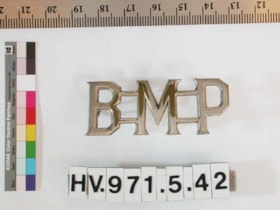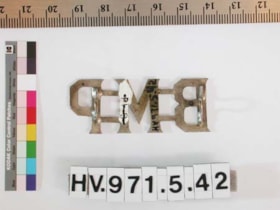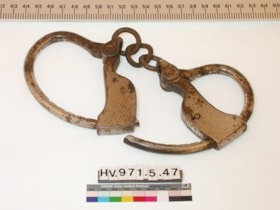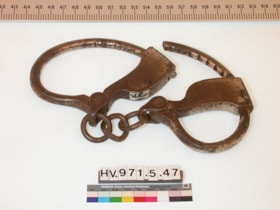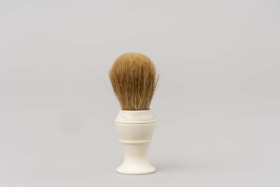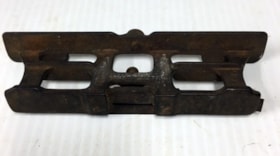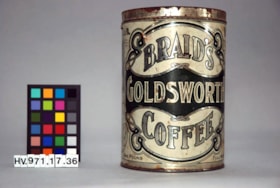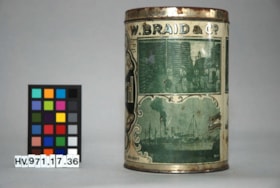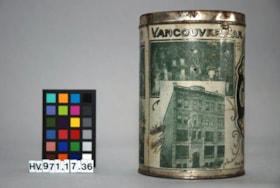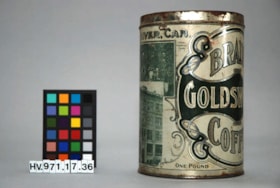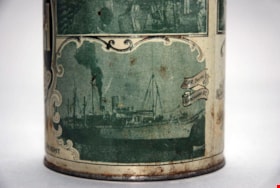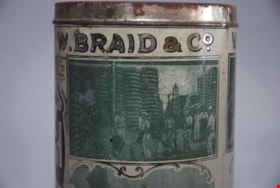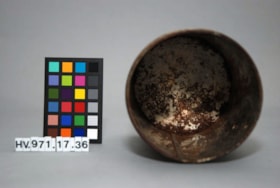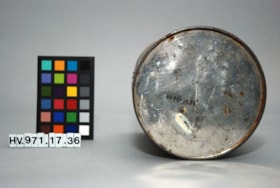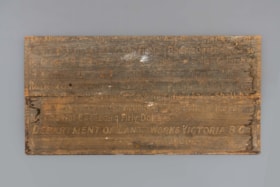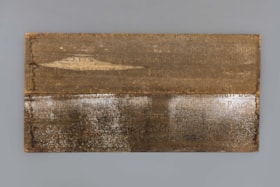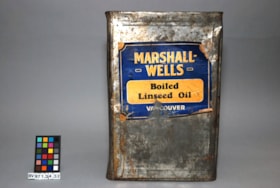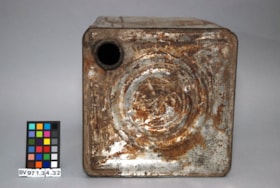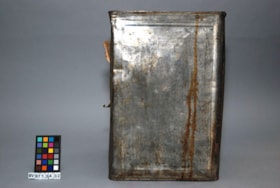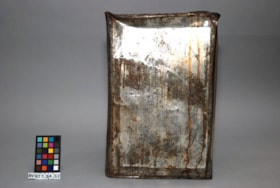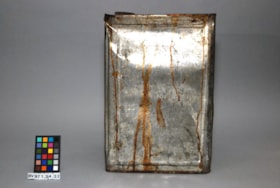Narrow Results By
Decade
- 2020s 71
- 2010s 132
- 2000s 227
- 1990s 354
- 1980s 372
- 1970s 569
- 1960s 346
- 1950s 419
- 1940s 408
- 1930s 365
- 1920s 309
- 1910s 234
- 1900s 115
- 1890s 41
- 1880s 11
- 1870s 11
- 1860s 11
- 1850s 10
- 1840s 5
- 1830s 3
- 1820s 3
- 1810s 3
- 1800s 3
- 1790s 2
- 1780s 2
- 1770s 2
- 1760s 2
- 1750s 2
- 1740s 2
- 1730s 2
- 1720s 2
- 1710s 2
- 1700s 2
- 1690s 2
- 1680s 2
- 1670s 1
- 1660s 1
- 1650s 1
- 1640s 1
- 1630s 1
- 1620s 1
- 1610s 1
- 1600s 1
Subject
- Academic Disciplines 3
- Accidents - Automobile Accidents 3
- Accidents - Train Accidents 2
- Adornment 3
- Adornment - Lapel Pins 4
- Advertising Medium 33
- Advertising Medium - Business Cards 5
- Advertising Medium - Flyer 14
- Advertising Medium - Poster 1
- Advertising Medium - Signs and Signboards 31
- Aerial Photographs 40
- Agriculture 11
Interview with W.H. O'Brien July / August 1975 - Track 8
https://search.heritageburnaby.ca/link/oralhistory25
- Repository
- City of Burnaby Archives
- Date Range
- [1932]-1936
- Length
- 0:11:12
- Summary
- This portion of the interview pertains to W.H. "Harry" O'Brien's involvement with the formation of the Army of the Common Good Credit Union (now the South Burnaby Credit Union).
- Repository
- City of Burnaby Archives
- Summary
- This portion of the interview pertains to W.H. "Harry" O'Brien's involvement with the formation of the Army of the Common Good Credit Union (now the South Burnaby Credit Union).
- Date Range
- [1932]-1936
- Photo Info
- Harry and Gertrude (Sutherland) O'Brien on their wedding day, October 12, 1940. Item no. 315-005
- Length
- 0:11:12
- Subjects
- Organizations
- Interviewer
- Bradbury, Dr. Bettina
- Interview Date
- July / August 1975
- Scope and Content
- Recording is a taped interview with W.H. "Harry" O'Brien by SFU (Simon Fraser University) graduate student Bettina Bradbury. Major themes discussed are: the Army of the Common Good, the Union of the Unemployed and the Common Good Credit Union (now the South Burnaby Credit Union). To view "Narrow By" terms for each track expand this description and see "Notes".
- Biographical Notes
- W.H. “Harry” O’Brien was born in the coal mining town of Nanaimo, British Columbia on October 20, 1914. He came to Burnaby with his parents and five siblings in 1927. Harry’s mother, a school teacher, wanted her children to live closer to school in order to obtain a better education, so the O’Brien family settled at Inman Avenue, Burnaby. Harry's mother, Mary Anne Crossan, was Gilmore Avenue School's first teacher. Harry left school in June of 1929. Harry’s father worked as the caretaker at Central Park around this time and Harry helped him to clear brush, plant trees and enforce the land clearing and wood cutting permit regulations held by men who were on script. Although too young to vote by just over a week, Harry O'Brien worked as a scrutineer for the Co-operative Commonwealth Federation (CCF) during the 1935 Federal Election. On October 12, 1940 Harry O'Brien married Gertrude Sutherland at St. John the Divine in Burnaby. The Sutherland family came to Burnaby from Winnipeg in 1933 and settled at Nelson Avenue. Harry began his involvement with the Unemployment Organization in Burnaby by participating in an organised protest against the municipality for homeowner evictions brought on by unpaid taxes. The South Burnaby Union of the Unemployed organised in order to protest rules around receiving Relief. Harry became involved, eventually becoming one of the spearheads of the organization, taking over as secretary by 1936. Harry was an original member of the Army of the Common Good, helping to produce over one hundred and twenty-five tons of vegetables from its own gardens to feed Burnaby citizens suffering from the lack of resources during the Depression years. The members of the Army of the Common Good who cut wood for consumption or worked in the gardens were given credit for their work through LU (Labour Units) which they could then use to buy groceries and that at the Army's Cooperative stores, one of which was at McKay Avenue, where Harry began working as Manager of Groceries in 1937. The Credit Union movement of British Columbia was also organized by Harry O'Brien and his fellow Army of the Common Good members. W.H. "Harry" O'Brien died July 1, 1992.
- Total Tracks
- 9
- Total Length
- 1:17:56
- Interviewee Name
- O'Brien, Harry
- Interviewer Bio
- Bettina Bradbury teaches history and women's studies at York University. She is the author of Wife to Widow. Lives, Laws and Politics in Nineteenth-century Montreal. (Vancouver: University of British Columbia Press, June 2011), 520p; Working Families. Age, Gender and Daily Survival in Industrializing Montreal. (Toronto: Canadian Social History Series, McClelland and Stewart, 1993); (Republished Toronto: Oxford University Press, 1996) (3rd edition, Toronto: University of Toronto Press, 2007). These interviews were undertaken after she completed her MA at Simon Fraser University in 1975 with the support of an LIP grant.
- Collection/Fonds
- Burnaby Historical Society fonds
- Subseries
- Oral history subseries
- Transcript Available
- None
- Media Type
- Sound Recording
- Web Notes
- Interview was digitized in 2010 allowing it to be accessible on Heritage Burnaby. The digitization project was initiated by the Community Heritage Commission with support from City of Burnaby Council and the BC History Digitization Program of the Irving K. Barber Learning Centre, University of British Columbia. It was recognized by the Heritage Society of BC with an award in 2012.
Images
Audio Tracks
Track eight of interview with W.H.
Track eight of interview with W.H.
https://search.heritageburnaby.ca/media/hpo/_Data/_Archives_Oral_Histories/_Unrestricted/100-13-25/100-13-25_Track_8.mp3Andrew Johnson subseries
https://search.heritageburnaby.ca/link/archivedescription4
- Repository
- City of Burnaby Archives
- Date
- [1880]-[1940]
- Collection/Fonds
- Burnaby Historical Society fonds
- Description Level
- Subseries
- Physical Description
- Photographs and drawings
- Scope and Content
- Subseries consists of photographs and drawings of members of the Johnson family and their home.
- Repository
- City of Burnaby Archives
- Date
- [1880]-[1940]
- Collection/Fonds
- Burnaby Historical Society fonds
- Subseries
- Andrew Johnson subseries
- Physical Description
- Photographs and drawings
- Description Level
- Subseries
- Access Restriction
- No restrictions
- Accession Number
- BHS1990-10
- BHS1997-16
- Scope and Content
- Subseries consists of photographs and drawings of members of the Johnson family and their home.
- History
- Andrew Martin Johnson was born in Norway in 1861 and immigrated to Vancouver, British Columbia in 1886. His wife Margaret Sloane was born in Ireland. Margaret and Andrew Johnson's eldest child, Edward Sloane, was born June 10, 1901 but did not survive infancy. Their second child, Andrew Sloane, was born in 1906. Andrew Martin was a major landowner in Burnaby, at one time owning each of the four corners of Royal Oak and Kingsway and many of the adjacent properties. He made his fortune as a partner in the firm of Atkins & Johnson, a leading transportation company in Vancouver which later became the Mainland Transfer Company. In 1910, Andrew Martin purchased Burnaby's Royal Oak Hotel. He soon acquired the property on the opposite corner to build their family home, called "Glenedward" after their eldest son. He owned and operated the Royal Oak Hotel until his death on September 18, 1934. In 1943 Margaret sold Glenedward. The building has since been converted twice: first into the Royal Oak Funeral Chapel and then into the Johnson House Korean Restaurant. Andrew Sloane Johnson attended Kingsway West School and Britannia High School before earning a Bachelor's of Business Administration at the University of Washington in 1930. He lived at Glenedward until moving to Washington for school.
- Media Type
- Photograph
- Textual Record
- Creator
- Johnson, Andrew Martin
- Notes
- Title based on contents of subseries
- PC244, PC335
Fraser Wilson subseries
https://search.heritageburnaby.ca/link/archivedescription58314
- Repository
- City of Burnaby Archives
- Date
- [19--]-1969
- Collection/Fonds
- Burnaby Historical Society fonds
- Description Level
- Subseries
- Physical Description
- Textual records nd graphic material
- Scope and Content
- Subseries consists of one photographic album of locations in Vancouver photographed in the 1880s, sixteen original illustrations by Fraser Wilson and three files of textual records, including the comic book "Bill Northwood".
- Repository
- City of Burnaby Archives
- Date
- [19--]-1969
- Collection/Fonds
- Burnaby Historical Society fonds
- Subseries
- Fraser Wilson subseries
- Physical Description
- Textual records nd graphic material
- Description Level
- Subseries
- Accession Number
- BHS1988-06
- BHS1985-23
- BHS1991-25
- Scope and Content
- Subseries consists of one photographic album of locations in Vancouver photographed in the 1880s, sixteen original illustrations by Fraser Wilson and three files of textual records, including the comic book "Bill Northwood".
- History
- Fraser Wilson was born in Vancouver on July 1, 1905 and brought up in the Grandview area, with fond memories of berry picking in the wilds of North Burnaby as a child. He left school in 1923 and, although interested in art, he didn’t try to make it a career until a double hernia forced him to stop working in factories and start apprenticing for commercial artists, later opening a sign shop of his own. In 1926 he worked in Australia as a set decoration painter, but had to return to Vancouver when his father fell ill in 1927. Wilson was a political cartoonist for the Vancouver Sun newspaper from 1937 to 1947. When he moved to Burnaby in April of 1943 he was also the artist and author of the cartoon-type serial “Bill Northwood - the personification of the modern Resource Manager” which served to teach the community why forests are important and should be preserved. He lost his job at the Vancouver Sun in 1947; he was the chairman of the Co-ordinating Committee of Newspaper Unions which was involved in the Vancouver Province strike and his publisher didn’t approve. Soon after, Bill White, then-president of the Marine Workers’ and Boilermakers Union, asked Wilson to decorate the Marine Workers’ Auditorium at 3337 West Pender, the Union's hall. The mural that Wilson painted depicts the BC labour movement to honour British Columbia’s workers. This mural launched a new career for Wilson; to this day, hospitals and libraries across British Columbia display his work in lobbies. In 1988, when the building housing the Marine Workers’ Auditorium was sold to a new owner, Fraser Wilson’s mural was removed from the wall, restored by Ferdinand Petrov of the Vancouver Centennial Committee, and installed permanently at the new Maritime Labour Centre on Victoria Drive in Vancouver. Throughout the 1960s, Wilson served as president of the Burnaby Historical Society. He ran for City Council as a Burnaby Citizens Association candidate in 1969 and 1970. Fraser Wilson died on 31 July 1992.
- Media Type
- Textual Record
- Photograph
- Creator
- Wilson, Fraser
- Notes
- PC492, MSS062
- Title based on contents of subseries
Locations in Vancouver and British Columbia
https://search.heritageburnaby.ca/link/archivedescription58315
- Repository
- City of Burnaby Archives
- Date
- [19--]
- Collection/Fonds
- Burnaby Historical Society fonds
- Description Level
- Item
- Physical Description
- 1 album (61 photographs : b&w) ; 26.5 x 31.5 cm
- Scope and Content
- Photographic album of locations in Vancouver, the Lower Mainland, and other locations in British Columbia and Alberta. Photographs are reproductions of photographs taken between approximately 1880-1900, which were collected and pasted into the album.
- Repository
- City of Burnaby Archives
- Date
- [19--]
- Collection/Fonds
- Burnaby Historical Society fonds
- Subseries
- Fraser Wilson subseries
- Physical Description
- 1 album (61 photographs : b&w) ; 26.5 x 31.5 cm
- Description Level
- Item
- Record No.
- 492-001
- Access Restriction
- In Archives only
- Reproduction Restriction
- No reproduction permitted
- Accession Number
- BHS1988-06
- Scope and Content
- Photographic album of locations in Vancouver, the Lower Mainland, and other locations in British Columbia and Alberta. Photographs are reproductions of photographs taken between approximately 1880-1900, which were collected and pasted into the album.
- Names
- Wilson, Fraser
- Media Type
- Photograph
- Notes
- Title based on content of item
- Table of contents of pictures and page numbers pasted in the front cover of the album
- 1 photograph loose in between pages 12-13 of the album; reproduction of a photograph from Vancouver City Archives.
Hazel Peterson subseries
https://search.heritageburnaby.ca/link/archivedescription62793
- Repository
- City of Burnaby Archives
- Date
- [188-]-[2000]
- Collection/Fonds
- Burnaby Historical Society fonds
- Description Level
- Subseries
- Physical Description
- Photographs and textual records
- Scope and Content
- Subseries consists of photographs and textual records, including marriage and baptism certificates, belonging to Hazel Erickson Peterson and her family.
- Repository
- City of Burnaby Archives
- Date
- [188-]-[2000]
- Collection/Fonds
- Burnaby Historical Society fonds
- Subseries
- Hazel Peterson subseries
- Physical Description
- Photographs and textual records
- Description Level
- Subseries
- Accession Number
- BHS2000-08
- Scope and Content
- Subseries consists of photographs and textual records, including marriage and baptism certificates, belonging to Hazel Erickson Peterson and her family.
- History
- Hazel Eleanora Erickson was born May 21, 1896 in San Francisco California and baptized on December 25, 1899. She was the daughter of Charles Victor Erickson and Amanda Hedvig Erickson of Sweden. Her parents were married in Oakland, California on January 20, 1894. The Erickson family lived in San Francisco, then travelled up the panhandle to Alaska. They travelled throughout British Columbia and by the 1920s made Burnaby their home. Hazel Erickson was living at Gibson's Landing, British Columbia by the time of her marriage on August 31, 1936 to Edwin Peterson. Edwin Peterson was born at sea on October 18, 1884 and became naturalized as a British subject from the Dominion of Canada in 1921. He was an electrician by trade. Hazel resided at the Dania Home in Burnaby for 20 before her death in 1996.
- Media Type
- Photograph
- Textual Record
- Creator
- Peterson, Hazel Erickson
- Notes
- Title based on creator of subseries
- MSS094, PC504
Pioneer Tales subseries
https://search.heritageburnaby.ca/link/archivedescription97276
- Repository
- City of Burnaby Archives
- Date
- [191-] (date of original)-1988
- Collection/Fonds
- Burnaby Historical Society fonds
- Description Level
- Subseries
- Physical Description
- Photographs and textual records
- Scope and Content
- Subseries consists of photographs compiled by the Mayor's Office for inclusion in the publication "Pioneer Tales of Burnaby" and drafts of the manuscript.
- Repository
- City of Burnaby Archives
- Date
- [191-] (date of original)-1988
- Collection/Fonds
- Burnaby Historical Society fonds
- Subseries
- Pioneer Tales subseries
- Physical Description
- Photographs and textual records
- Description Level
- Subseries
- Accession Number
- BHS2007-04
- BHS1988-03
- Scope and Content
- Subseries consists of photographs compiled by the Mayor's Office for inclusion in the publication "Pioneer Tales of Burnaby" and drafts of the manuscript.
- History
- On May 28, 1980 the Mayor and Council of Burnaby held a tea to honour Burnaby “pioneers.” The event was held as part of “Burnaby Funfest Days ‘80” and was meant to recognize members of the community who had resided in Burnaby prior to 1930 and acknowledge their contributions as pioneers of the City. Although approximately 100 people were expected, more than 500 actually attended. Each participant was asked to fill out a brief personal information form outlining their experiences in Burnaby’s earliest days. The response was so favorable that the idea of compiling a book to capture these memories was born. The City hired a writer edit and organize the book they held writing contests to encourage senior residents to share their experiences. Other community members became involved in the project when the City enlisted the help of secondary school students to type manuscripts for those unable to do so and journalism students from the British Columbia Institute of Technology to conduct interviews with additional “pioneers.” The book was published in 1987.
- Media Type
- Textual Record
- Photograph
- Creator
- Mayor's Office
- Notes
- Title based on contents of subseries
- PC204, MSS064
Railways
https://search.heritageburnaby.ca/link/archivedescription98236
- Repository
- City of Burnaby Archives
- Date
- [date unknown]
- Collection/Fonds
- Burnaby Historical Society fonds
- Description Level
- File
- Physical Description
- 2 maps : col. ; 89 cm x 76 cm
- Scope and Content
- File contains sheet 7 and 8 of a map of Canadian railways. Sheets depict British Columbia, Yukon, and the eastern portions of Albert and Northwest Territories. Sheet 7 includes an index of railways.
- Repository
- City of Burnaby Archives
- Date
- [date unknown]
- Collection/Fonds
- Burnaby Historical Society fonds
- Subseries
- Ephemera subseries
- Physical Description
- 2 maps : col. ; 89 cm x 76 cm
- Description Level
- File
- Record No.
- 64999
- Accession Number
- BHS2007-04
- Scope and Content
- File contains sheet 7 and 8 of a map of Canadian railways. Sheets depict British Columbia, Yukon, and the eastern portions of Albert and Northwest Territories. Sheet 7 includes an index of railways.
- Media Type
- Cartographic Material
- Notes
- Title based on contents of files
Mortimer-Lamb House
https://search.heritageburnaby.ca/link/landmark494
- Repository
- Burnaby Heritage Planning
- Description
- The Mortimer-Lamb House is a one and one half-storey, Arts and Crafts-style residence with a steeply pitched, side-gabled roof. The original cottage form has been enlarged with a later addition on the west side of the house. Located next to the Burnaby Lake Regional Park Wildlife Rescue Care Centre…
- Associated Dates
- c.1922
- Formal Recognition
- Community Heritage Register
- Other Names
- Harold & Katherine Mortimer-Lamb Residence
- Street View URL
- Google Maps Street View
- Repository
- Burnaby Heritage Planning
- Other Names
- Harold & Katherine Mortimer-Lamb Residence
- Geographic Access
- Glencarin Drive
- Associated Dates
- c.1922
- Formal Recognition
- Community Heritage Register
- Enactment Type
- Council Resolution
- Enactment Date
- 26/05/2003
- Description
- The Mortimer-Lamb House is a one and one half-storey, Arts and Crafts-style residence with a steeply pitched, side-gabled roof. The original cottage form has been enlarged with a later addition on the west side of the house. Located next to the Burnaby Lake Regional Park Wildlife Rescue Care Centre, the house has picturesque views of Burnaby Lake.
- Heritage Value
- Built circa 1922, the Mortimer-Lamb House is valued for its association with first owners, Harold Mortimer-Lamb (1872-1970), and his wife, Katherine Mary Mortimer-Lamb (1873-1939). Born in Leatherhead, Surrey, England, Harold Mortimer-Lamb immigrated to Canada in 1889. Seven years later in Vancouver, he married Katherine Mary Lindsay, a native of Winnipeg. Mortimer-Lamb was a key figure in the B.C. mining industry, serving as Secretary of the Mining Association of B.C. between 1900 and 1945, and also as the Secretary of the Canadian Institute of Mining and Metallurgy. In addition to his professional life, Mortimer-Lamb was a pioneer art photographer and was among Canada's leading art critics, and this house served as a central gathering place for renowned Canadian artists of the day. Mortimer-Lamb’s daughter, Molly Lamb Bobak (born 1922), became a renowned watercolourist, and was the only woman ever hired as an official Canadian war artist. The Mortimer-Lamb House is a significant example of the work of noted architect, Samuel Maclure (1860-1929) and his partner, Ross Lort (1889-1969). Maclure, who was a close friend of the Mortimer-Lamb family, was British Columbia's leading residential architect, and was renowned for his high quality designs for prominent citizens in both Vancouver and Victoria. Maclure was a leading exponent of the Art and Crafts design movement in B.C., and established a sophisticated local variation of residential architecture. The Mortimer-Lamb House was designed at the time when Maclure was in partnership with Ross Lort. In 1907, Lort began working for Maclure's firm as a draftsman, and by 1920 was in charge of Maclure's Vancouver office. Lort's architectural career spanned some sixty-years, and he designed some of the province's most familiar houses, apartments, institutions and places of worship. The Mortimer-Lamb House is also a significant local example of the Arts and Crafts style, and incorporates elements such as board-and-batten siding on the ground floor, shingled gables and leaded casement windows. It is a testament to the domestic architecture built outside of established suburbs during the post-First World War era, typically modest in scale and representative of middle-class residential ideals.
- Defining Elements
- Key elements that define the heritage character of the Mortimer-Lamb House include its: - treed setting with views of Burnaby Lake - residential form, scale and massing as expressed by its one and one-half storey height, rectangular plan and steeply pitched side-gabled roof - wood-frame construction - Arts and Crafts elements such as board-and-batten siding on the ground floor, cedar shingles in the gables and open soffits - original straight-leaded casement windows in single and multiple-assembly - internal red-brick chimney with corbelled cap
- Historic Neighbourhood
- Burnaby Lake (Historic Neighbourhood)
- Planning Study Area
- Burnaby Lake Area
- Organization
- Mining Association of B.C.
- G.F. and J. Galt Limited
- Architect
- Samuel Maclure
- Ross Lort
- Function
- Primary Historic--Single Dwelling
- Primary Current--Single Dwelling
- Community
- Burnaby Lake
- Cadastral Identifier
- P.I.D.002-977-788
- Boundaries
- The Mortimer-Lamb House is comprised of a single residential lot located at 5180 Glencairn Drive, Burnaby.
- Area
- 5652.78
- Contributing Resource
- Building
- Ownership
- Private
- Documentation
- City of Burnaby Planning and Building Department, Heritage Site Files
- Street Address
- 5180 Glencarin Drive
- Street View URL
- Google Maps Street View
Images
Burnaby Lake Neighbourhood
https://search.heritageburnaby.ca/link/landmark733
- Repository
- Burnaby Heritage Planning
- Repository
- Burnaby Heritage Planning
- Heritage Value
- After New Westminster was established as the Capital City, the surrounding lands were surveyed by the Royal Engineers. The discovery of Burnaby Lake by Robert Burnaby in 1859 soon led to the construction of Douglas Road to Deer Lake in 1861. The completion of the tramline in 1891 renewed interest in the lands around both Burnaby Lake and Deer Lake and soon a group of gentlemen farmers had established strawberry fields and orchards to serve the New Westminster market. These were the most productive and well managed "fruit ranches" in the Fraser Valley. Local strawberries were so admired that they commanded 50 cents more per crate at local markets. One local paper reported that the area appeared as if "an English Village had been taken and planted amidst the grandeur of British Columbia scenery."
- Historic Neighbourhood
- Burnaby Lake (Historic Neighbourhood)
- Planning Study Area
- Douglas-Gilpin Area
Images
Edmonds Neighbourhood
https://search.heritageburnaby.ca/link/landmark758
- Repository
- Burnaby Heritage Planning
- Associated Dates
- 1905-1924
- Heritage Value
- From The British Columbian, March 19, 1912: "On the fringe of New Westminster there is…a suburban townsite in Edmonds. During the past eighteen months it has grown and prospered quite phenomenally. It is ideally situated, is in easy communication with New Westminster by two car lines. Its climate is clear and bracing, being exceptionally free from the fogs that are more or less prevalent along the river section and gulf shore...Edmonds, in fact, is one of the finest residential parts of the province. This is fast becoming known and appreciated beyond its borders. Elegant and substantial residences are being erected in various parts, and stores are being put up in convenient localities. The new municipal building is one of the finest in British Columbia for so young a municipality."
- Historic Neighbourhood
- Edmonds (Historic Neighbourhood)
- Planning Study Area
- Edmonds Area
Images
Burnaby Mountain Neighbourhood
https://search.heritageburnaby.ca/link/landmark792
- Repository
- Burnaby Heritage Planning
- Associated Dates
- 1955-2008
- Heritage Value
- Burnaby Mountain had been dedicated as park in 1942, however the original park boundaries were reconsidered in 1952 with the development of the Trans Mountain Pipeline. Although the boundaries were adjusted to accommodate this project, significant conservation and park lands were left untouched. When, in 1962, the government of British Columbia determined the need for additional post-secondary facilities, Burnaby Mountain was chosen as the site for the new Simon Fraser University which opened in 1965. As early as 1964, the idea of establishing a townsite around the university had been discussed by Burnaby, but it was not until the mid-1990s that the idea came to fruition and by the early 2000s, a new housing development know as the UniverCity took shape on the mountain adjacent to the university.
- Historic Neighbourhood
- Barnet (Historic Neighbourhood)
- Planning Study Area
- Burnaby Mountain Area
Images
Lake City Neighbourhood
https://search.heritageburnaby.ca/link/landmark793
- Repository
- Burnaby Heritage Planning
- Associated Dates
- 1955-2008
- Heritage Value
- When Simon Fraser University opened in 1965, approximately sixteen industrial properties had been developed in the Lake City Industrial Park. In addition, significant tracts of land in the western portion had been pre-cleared and graded in anticipation of additional development, while most of the eastern half remained forested. Some of the early companies to locate in the area were Nabob Foods, Volkswagen Canada, British Columbia Television Broadcasting, Simpson Sears, and H.Y. Louie Company Limited. Both Imperial Oil and Shell Oil established petroleum storage and distribution facilities in the area. Initially a heavy industrial area, by 1979, single family neighbourhoods south of Lougheed Highway and west of Eagle Creek had been largely developed. By the mid1980's, the Burnaby 200 multi-family development along Forest Grove Drive had also been completed.
- Planning Study Area
- Lake City Area
Images
shoulder badge
https://search.heritageburnaby.ca/link/museumartifact204
- Repository
- Burnaby Village Museum
- Accession Code
- HV971.5.42
- Description
- Burnaby Municipal Police shoulder bar for jacket. Cast in one piece in metal. Letters are connected by integral bars. Secured by mounting posts and cotter pin.
- Object History
- Jacket shoulder bars issued to Constable George Jeffery. George Jeffery served as a Constable on the Burnaby Police Force from 1912 - 1935. His patrolled the large Central Park District by foot, stretching from Boundary to Royal Oak and Marine Drive to Moscrop. Over the coarse of his duties, Constable Jeffery saw the need for recreational activities in the area. He founded the Burnaby Athletic Association which featured a competitive boxing ring and gym. In 1935, when the Burnaby Police became the British Columbia Provincial Police, rather than leave the community he chose to leave the force. George Jeffery than worked at the nearby Oakalla Prison Farm until retiring in 1945.
- Marks/Labels
- "B M P", letters on cross bars
Images
handcuffs
https://search.heritageburnaby.ca/link/museumartifact209
- Repository
- Burnaby Village Museum
- Accession Code
- HV971.5.47
- Description
- Burnaby Municipal Police issue handcuffs. The cuffs are secured by three links of chain. There is no key.
- Object History
- These handcuffs were used by Constable George Jeffery. George Jeffery served as a Constable on the Burnaby Police Force from 1912 - 1935. His patrolled the large Central Park District by foot, stretching from Boundary to Royal Oak and Marine Drive to Moscrop. Over the coarse of his duties, Constable Jeffery saw the need for recreational activities in the area. He founded the Burnaby Athletic Association which featured a competitive boxing ring and gym. In 1935, when the Burnaby Police became the British Columbia Provincial Police, rather than leave the community he chose to leave the force. George Jeffery than worked at the nearby Oakalla Prison Farm until retiring in 1945.
Images
name plate
https://search.heritageburnaby.ca/link/museumartifact210
- Repository
- Burnaby Village Museum
- Accession Code
- HV971.5.48
- Description
- Name plate "GEO. JEFFERY" made for Burnaby Municipal Police officer George Jeffery by schoolchildren. Rectangular copper plate with letters and border raised by hammering on the reverse side. Background is darkened by acid treatment.
- Object History
- Made for Burnaby Municipal Police officer George Jeffery by schoolchildren. George Jeffery served as a Constable on the Burnaby Police Force from 1912 - 1935. His patrolled the large Central Park District by foot, stretching from Boundary to Royal Oak and Marine Drive to Moscrop. Over the coarse of his duties, Constable Jeffery saw the need for recreational activities in the area. He founded the Burnaby Athletic Association which featured a competitive boxing ring and gym. In 1935, when the Burnaby Police became the British Columbia Provincial Police, rather than leave the community he chose to leave the force. George Jeffery then worked at the nearby Oakalla Prison Farm until retiring in 1945.
- Marks/Labels
- "GEO. JEFFERY", letters raised by hammering.
Images
Shaving brush
https://search.heritageburnaby.ca/link/museumartifact212
- Repository
- Burnaby Village Museum
- Accession Code
- HV971.5.50
- Description
- Handheld shaving brush with a white plastic base and tan bristles. Used for mixing and applying shaving cream.
- Object History
- This item belonged to George Jeffery served as a Constable on the Burnaby Police Force from 1912 - 1935. His patrolled the large Central Park District on foot, stretching from Boundary to Royal Oak and Marine Drive to Moscrop. Over the coarse of his duties, Constable Jeffery saw the need for recreational activities in the area. He founded the Burnaby Athletic Association which featured a competitive boxing ring and gym. In 1935, when the Burnaby Police became the British Columbia Provincial Police, rather than leave the community he chose to leave the force. George Jeffery then worked at the nearby Oakalla Prison Farm until retiring in 1945.
- Category
- 03. Personal Artifacts
- Classification
- Personal Gear - - Personal Assistive Artifacts
- Object Term
- Brush
- Marks/Labels
- On the base of the brush "STERILIZED ADGER" "MADE IN" "CANADA" "PEERLESS" "PURE".
- Subjects
- Toilet Articles
- Historic Neighbourhood
- Central Park (Historic Neighbourhood)
- Planning Study Area
- Oakalla Area
Images
Saw jointer and gauge
https://search.heritageburnaby.ca/link/museumartifact244
- Repository
- Burnaby Village Museum
- Accession Code
- HV971.5.82
- Description
- A cast iron gauge of the same design as the Atkins excelsior saw tool Co. It is approximately rectangular in shape with three horizontal bands and four vertical supporting pillars. On the top a set screw is present. A notch is present in the base plate held in place with two short slotted screws and with a smaller adjustment screw above. Markings cast into the saw gauge appear to be: On one side: "MORIN" "PAT/69" "JUNE" "S.J." "SEATTLE" On the other side: "SEATTLE" "1900"
- Object History
- George Jeffery served as a Constable on the Burnaby Police Force from 1912 - 1935. His patrolled the large Central Park District by foot, stretching from Boundary to Royal Oak and Marine Drive to Moscrop. Over the coarse of his duties, Constable Jeffery saw the need for recreational activities in the area. He founded the Burnaby Athletic Association which featured a competitive boxing ring and gym. In 1935, when the Burnaby Police became the British Columbia Provincial Police, rather than leave the community he chose to leave the force. George Jeffery then worked at the nearby Oakalla Prison Farm until retiring in 1945.
- Measurements
- Overall measurements: Length: 16.6 cm Width: 2.5 cm Height: 4.4 cm
- Names
- Oakalla Prison Farm
Images
coffee tin
https://search.heritageburnaby.ca/link/museumartifact760
- Repository
- Burnaby Village Museum
- Accession Code
- HV971.17.36
- Description
- Coffee tin; front of tin has logo with decorative design, sides of tin have four green tinted photographs of Vancouver and area
- Marks/Labels
- "BRAID'S / GOLDSWORTH / COFFEE", painted "ONE POUND" (small), painted "FULL WEIGHT" (small), printed "W.BRAID & CO.", printed "VANCOUVER, CAN.", printed "CPR DOCKS / VANCOUVER BC", printed as photograph caption "THE BAND (?) BLOCK / VANCOUVER BC", printed as photograph caption
- Maker
- W. Braid & Company
- Country Made
- Canada
- Province Made
- British Columbia
- Site/City Made
- Vancouver
- Subjects
- Product Packaging
- Container
- Geographic Access
- Vancouver
Images
sign
https://search.heritageburnaby.ca/link/museumartifact1217
- Repository
- Burnaby Village Museum
- Accession Code
- HV971.33.1
- Description
- Weathered wood sign in two parts; informs readers of the penalty for attaching any raft, vessel, boat, etc., to wooden bridges in the province of British Columbia in 1902.
- Classification
- Written Communication T&E
- Object Term
- Sign
- Marks/Labels
- "The attention of Steamers and of any person in charge of any vessel, barge, boat, raft, or any floating body is directed to Clause 12 "Chapter 25" Bridges Act of the Revised Statutes of British Columbia. Any person that shall moor, make or last or in any other way "Attach" any raft, vessel, boat, barge or any other floating body to any wooden or other bridge... shall be.. not exceeding fifty dollars. Department of Land and Works, Victoria, BC 23rd June 1902.
- Subjects
- Recreational Activities - Boating
- Regulative and Protective Tools and Equipment
- Transportation - Boats
- Written Communication Tools and Equipment
Images
container
https://search.heritageburnaby.ca/link/museumartifact1249
- Repository
- Burnaby Village Museum
- Accession Code
- HV971.34.32
- Description
- container, large metal box, square and tall, no lid; one side blue label with yellow and white writing and yellow panel with blue writing; dented, scratched; drips all over; small round opening on top at back left corner
- Marks/Labels
- blue label one side with yellow "MARSHALL- WELLS", then yellow panel with blue "Boiled Linseed Oil", then white "VANCOUVER" "Form 140" in corner of label
- Maker
- Marshall- Wells
- Country Made
- Canada
- Province Made
- British Columbia
- Site/City Made
- Vancouver
- Subjects
- Product Packaging
- Container






